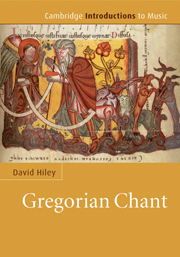Book contents
- Frontmatter
- Contents
- List of illustrations
- List of musical examples
- Note on the musical examples
- List of tables
- List of text boxes
- Preface
- Note on front cover illustration
- Chapter 1 Gregorian chant in the service of the church
- Chapter 2 The beginnings of Gregorian chant; other rites and other sorts of chant
- Chapter 3 Tradition and innovation in medieval chant: from the ninth to the sixteenth century
- Chapter 4 Thinking about Gregorian chant in the Middle Ages, and notating it
- Chapter 5 New chants for new times: from the sixteenth century to the present; aspects of performance
- Map of places from which important medieval chant manuscripts are preserved
- Chronological table
- Statistical table of chant categories by mode
- Original manuscript sources for musical examples
- Glossary
- Bibliography
- Index
Preface
Published online by Cambridge University Press: 05 October 2014
- Frontmatter
- Contents
- List of illustrations
- List of musical examples
- Note on the musical examples
- List of tables
- List of text boxes
- Preface
- Note on front cover illustration
- Chapter 1 Gregorian chant in the service of the church
- Chapter 2 The beginnings of Gregorian chant; other rites and other sorts of chant
- Chapter 3 Tradition and innovation in medieval chant: from the ninth to the sixteenth century
- Chapter 4 Thinking about Gregorian chant in the Middle Ages, and notating it
- Chapter 5 New chants for new times: from the sixteenth century to the present; aspects of performance
- Map of places from which important medieval chant manuscripts are preserved
- Chronological table
- Statistical table of chant categories by mode
- Original manuscript sources for musical examples
- Glossary
- Bibliography
- Index
Summary
This book tries to answer some of the questions which are often raised about Gregorian chant: what is it about and why is it the way it is? where does it come from, who composed it, and for whom? These are questions about its history, and the book is orientated towards historical matters. Thinking about the nature of Gregorian chant may nevertheless help explain why so many are interested in it and like to listen to it. For it may very well be that more people listen to Gregorian chant today, or have heard it at some time or other, in some form or other, than at any time in history. In sheer numbers, that is, not as a percentage of the population in lands with a Christian heritage. Every so often a recording of Gregorian chant climbs towards the top of the sales charts (as I write these words, the singing of the monks of the Cistercian Abbey of Heiligenkreuz in Austria is making the running). No beat, no harmony, such simple note patterns! Sung quietly, free from tension, it is far removed indeed from modern music of almost every kind, and a welcome respite from the haste and clamour of everyday life. Its ‘other-worldly’ character appeals to esoteric movements, and it has been thoroughly exploited in branches of the entertainment industry.
By contrast with this popularity of Gregorian chant outside the church, things are less happy in the original home of chant, the worship of the Christian church.
Information
- Type
- Chapter
- Information
- Gregorian Chant , pp. xvii - xixPublisher: Cambridge University PressPrint publication year: 2009
